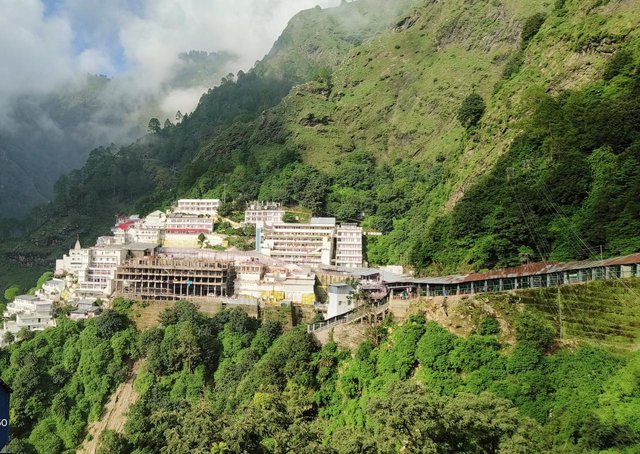The Vaishno Devi Yatra, located in the picturesque Trikuta Mountains of Jammu and Kashmir, is one of the most sacred pilgrimages for Hindus. The holy shrine of Mata Vaishno Devi is nestled amidst the serene and enchanting natural beauty of the region. Thousands of devotees undertake this pilgrimage every year, seeking the blessings of the Goddess. However, the journey to Vaishno Devi is not just a religious experience but also an adventure into the lap of nature. To make your yatra comfortable and spiritually fulfilling, here is a comprehensive guide with travel tips for your Vaishno Devi pilgrimage.

Planning Your Trip
- Selecting the Right Time: The best time to undertake the Vaishno Devi Yatra is during the cooler months, from March to October, to avoid harsh winter conditions. The pilgrimage is especially crowded during the Navratri festival.
- Registration: It's essential to register online for the yatra. The official website of the Shri Mata Vaishno Devi Shrine Board provides all the necessary information and registration options.
- Travel Documents: Ensure you have all your identification documents, including an ID proof and the yatra registration slip.
Reaching Vaishno Devi
- By Air: The nearest airport is Jammu Airport (IATA: IXJ). You can book a taxi from the airport to Katra, which is the base camp for the yatra.
- By Train: The nearest railway station is Katra Railway Station (code: SVDK), which is well-connected to major Indian cities. From there, you can either walk or hire a taxi to the starting point of the yatra.
- By Road: You can drive or take a bus to Katra, which is connected to Jammu by a good road network. From Katra, the yatra begins.
The Yatra Route
- The pilgrimage involves a trek of approximately 13 kilometers from Katra to the Bhawan, where the main shrine is located.
- The yatra can be completed by walking, on horses, or by taking a palanquin (palki). The journey is quite steep, so choose your mode of transport wisely.
Accommodation
- There are various accommodation options in Katra, ranging from budget hotels to luxury resorts. It's recommended to book your accommodation in advance, especially during peak pilgrimage seasons.
What to Pack
- Comfortable clothing, suitable for the season of your visit.
- Sturdy and comfortable walking shoes.
- Raincoat or umbrella, as the weather can be unpredictable.
- Basic medical kit, including any prescribed medications.
- A small backpack to carry essential items.
- Warm clothing for the nighttime, even in the warmer months.
Safety and Health Tips
- Altitude Sickness: While the altitude is not very high, some people may experience mild altitude sickness. Stay hydrated, take it slow, and consult a doctor if you have concerns.
- Food and Water: Consume food and water from trusted sources to avoid stomach issues. Carry some packaged snacks and water bottles.
- Medical Facilities: There are medical facilities along the yatra route. In case of an emergency, contact the nearest medical station.
- Travel Light: Avoid carrying unnecessary items, as the journey can be physically demanding.
Spiritual Aspects
- The yatra is not just about reaching the shrine but also about connecting with your inner self. Observe the rituals and engage in meditation and prayer.
- Do not forget to take a bath and change into clean clothes before starting the yatra. This is considered a symbolic cleansing.
- Keep in mind the spiritual significance of the journey and be respectful of the customs and traditions.

Important Stops Along the Yatra
- Ardhkuwari Cave: This is a mid-point where many pilgrims take a break. It's believed that Goddess Vaishno Devi spent nine months here meditating.
- Sanjichhat: It's a popular stop for refreshments and taking in the breathtaking views of the Trikuta Mountains.
- Bhairon Temple: This temple, located near the main shrine, is the final destination of the yatra. It is believed that the pilgrimage is incomplete without visiting the Bhairon Temple.
Local Culture and Etiquette
- While visiting religious places, it's important to be respectful of local customs and practices.
- Dress modestly, covering your shoulders and knees, and remove your shoes before entering any religious site.
- Be considerate of the environment. Avoid littering and respect the natural beauty of the region.
- Interact with local people respectfully and learn about their customs and way of life.
Cuisine
- The local food in Katra is primarily vegetarian, as it's a religious place. You can find delicious Indian and regional dishes. Do try the local Rajma Chawal and Kalaadi, a famous cheese dish.
- Hydrate well and stay away from heavy or spicy foods before the yatra.
Security Tips
- The entire yatra route is well-policed and safe. However, it's advisable to be cautious with your belongings and not trust strangers.
- Be aware of your surroundings and keep an eye on your valuables.
Photography and Videography
- Photography is allowed in many parts of the yatra, but there are restrictions at certain places. Respect the rules and the privacy of fellow pilgrims.
- Do not disturb the sanctity of the place by using flash or loud camera equipment.
Emergencies
- The yatra has well-established communication networks and security measures. In case of an emergency, contact the nearest security personnel or medical station.
The monastery is huge. The area surrounding it is beautiful. It reminds me of a few monasteries that I have seen here.
Downvoting a post can decrease pending rewards and make it less visible. Common reasons:
Submit